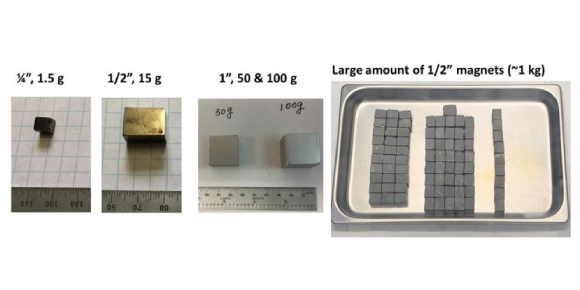Researchers optimise rare earth-free magnets through microstructure engineering
November 9, 2022

Researchers from the US Department of Energy’s Critical Materials Institute (CMI) and Ames National Laboratory, Ames, Iowa, USA, have published research in the Journal of Magnetism and Magnetic Materials demonstrating the property improvement of a rare earth-free permanent magnet material and how the process can be upscaled for manufacturing.
High-power permanent magnets, typically made of rare earth elements, are increasingly important for a variety of renewable-energy technologies. The problem with REEs, however, is that they are necessarily low stock despite their increasing demand, resulting in an unreliable supply chain and high prices. One solution, such as that trialled in “Engineering microstructure to improve coercivity of bulk MnBi magnet”, is to find alternative materials.
Most efforts in manufacturing bulk MnBi have run into the same problem: the densification process reduces the material’s coercivity (the ability to maintain the same level of magnetism). To overcome this, the researchers developed an alternative process.
Wei Tang – CMI researcher, Ames Lab scientist and this paper’s lead – stated that the team started with a very fine powder for each of the materials, thereby increasing the starting magnetic energy level. Next, they used a warm heating method rather than a high-temperature method to form the magnet. Finally – and the key to this new process – was the addition of a non-magnetic component that would keep the grain particles from touching each other. This additional element (a grain boundary phase) provides more structure to the magnet, and keeps the magnetism running through individual particles/grains from affecting one another.
“It is like the structural material,” Tang stated. “It’s like if we use concrete to build a wall: with just the concrete itself, it’s weak, but if we put a steel rebar inside first, then pour the concrete, it’s going to be several dozen times stronger.”
The effect of the warm temperature on the magnetic properties of MnBi is unique; the researchers expected the coercivity and magnetism to decrease with increasing temperature, which is true for most magnetic materials. However, for MnBi, the warm temperature increased the coercivity and decreased the magnetisation. This increased coercivity helps to keep the magnet more stable at elevated temperatures than other known magnets
The team also focused on making larger magnets, compared to the typically small magnets developed in labs. Upsizing the magnets helps to demonstrate to manufacturing companies that they can build large magnets on a commercial scale.
“If we cannot make the larger one, we cannot use it for any application,” Tang continued. “We need a big magnet, and we need to make it into whatever the shape needed. Also, we need to be able to mass produce at a low cost. This is important for future applications.”
The team is currently working with PowderMet Inc., Euclid, Ohio, using the company’s patent-pending techniques to pursue the mass production of MnBi magnets for use in novel electric motors. That project is funded by the Department of Energy Small Business Innovation Research programme. The project has already entered phase II, meaning it has been proven feasible and additional funding has been awarded to further develop and demonstrate the technology.














